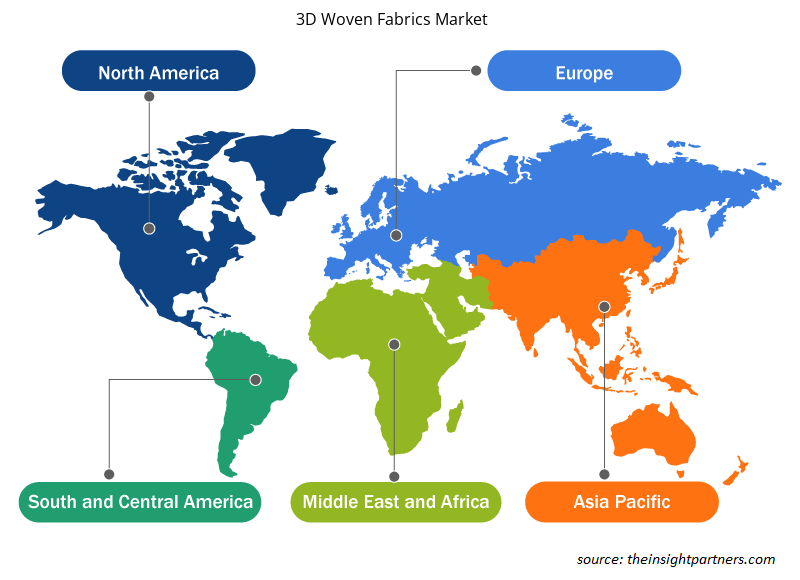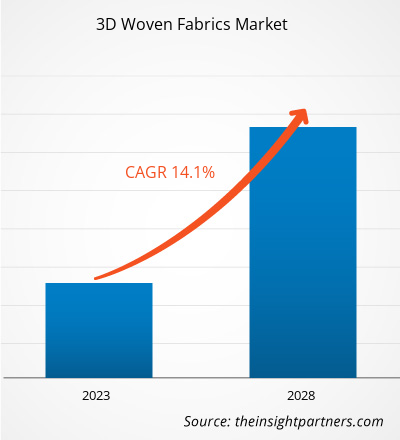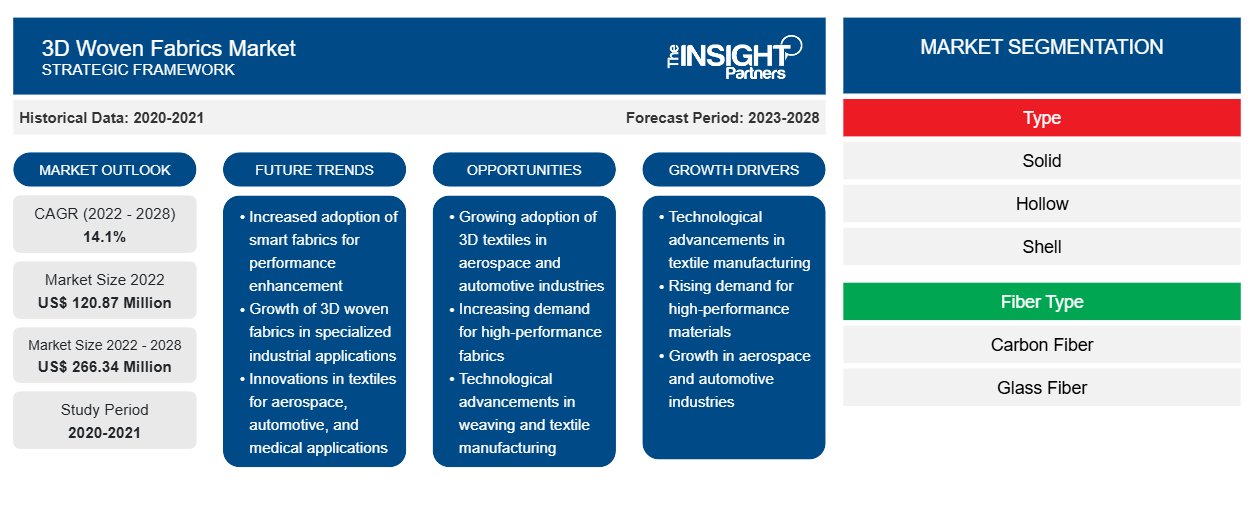[연구보고서] 3D 직물 시장 규모는 2022년 1억 2,087만 달러에서 2028년 2억 6,634만 달러로 성장할 것으로 예상되며, 2022년부터 2028년까지 연평균 성장률 14.1%로 성장할 것으로 추산됩니다.
3D 직물은 대부분의 목재와 금속에 비해 무게가 가볍습니다. 3D 직물의 가벼운 특성으로 인해 항공기와 자동차에서 사용이 중요하며, 무게가 적을수록 연료 효율이 더 좋습니다. 오늘날 항공기 설계자들은 무게에 대해 크게 우려하고 있습니다. 항공기의 무게를 줄이면 필요한 연료량이 줄어들고 도달할 수 있는 속도가 증가하기 때문입니다. 게다가 3D 직물은 날씨와 가혹한 화학 물질로 인한 손상을 견딥니다. 대부분의 다른 소재보다 복잡한 모양으로 더 쉽게 성형할 수 있습니다.
2022년 유럽은 글로벌 3D 직물 시장에서 가장 큰 3D 직물 시장 수익 점유율을 차지했습니다. 항공기, 자동차, 건설 및 기타 여러 최종 사용 산업에서 3D 직물을 활용하는 것과 관련된 R&D 활동이 증가함에 따라 유럽에서 3D 직물에 대한 수요가 증가하고 있습니다. 유럽의 3D 직물은 이 지역의 항공우주 및 자동차 산업을 위한 사업, 수출 및 고급 제조 응용 분야에 대한 기회를 창출할 수 있는 잠재력이 있습니다. 이로 인해 유럽에서 3D 직물의 인기가 빠르게 증가했습니다. 유럽 위원회에 따르면 유럽 연합은 2021년부터 2027년까지 연구 및 혁신 자금 지원 프로그램인 Horizon 2021에 약 1,030억 달러를 투자했습니다. 여기에는 운송 및 항공 분야에서 사용되는 고급 섬유를 개발하기 위한 자금이 포함되었습니다. 이러한 모든 요인은 이 지역의 3D 직물 시장 성장에 긍정적으로 기여합니다.
귀하의 요구 사항에 맞게 이 보고서를 사용자 정의하세요
이 보고서의 일부 또는 국가 수준 분석, Excel 데이터 팩을 포함하여 모든 보고서에 대한 사용자 정의를 무료로 받을 수 있으며 신생 기업 및 대학을 위한 훌륭한 혜택과 할인 혜택을 이용할 수 있습니다.
-
이 보고서의 주요 시장 동향을 알아보세요.이 무료 샘플에는 시장 동향부터 추정 및 예측까지 다양한 데이터 분석이 포함됩니다.
COVID-19 팬데믹이 3D 직물 시장에 미치는 영향
자동차, 항공우주, 건설 및 건설, 방위 및 군사와 같은 산업은 3D 직물 수요에 크게 기여했습니다. 2020년에 이러한 산업은 국가 및 국제 경계가 폐쇄되어 가치 사슬이 중단되어 운영 속도를 늦춰야 했습니다. 인력 부족으로 인해 3D 직물 생산 및 유통 운영이 둔화되었습니다. 글로벌 공급망의 중단과 수지 생산 시설의 폐쇄로 3D 직물 가격이 급등했습니다. 2020년에 여러 국가에서 시행한 봉쇄로 인해 산업이 재고 수준을 유지하는 능력이 저하되었습니다. 게다가 위생 조치 및 기타 COVID-19 예방 조치로 인해 생산 능력이 크게 감소하여 3D 직물 재고가 부족했습니다. 그러나 2021년에 여러 국가 정부가 사회적 제한을 완화한다고 발표하면서 글로벌 시장은 2020년에 발생한 손실에서 회복되기 시작했습니다. 게다가, 백신 접종률 증가는 다양한 국가의 전반적인 상황 개선에 기여하여 산업 및 상업적 발전에 유리한 환경으로 이어졌습니다. 나아가, 유럽과 북미의 자동차 및 기타 산업의 생산 용량 증가로 인해 2021년 3D 직물에 대한 수요가 증가했습니다.
시장 통찰력
자동차 및 항공기 산업에서 3D 직물에 대한 수요 증가
첨단 소재는 현대 자동차의 연비를 높이고 안전성과 성능을 보장하는 데 필수적입니다. 주철 및 기존 강철 구성 요소를 고강도 3D 직물과 같은 경량 소재로 대체하면 차량 차체와 섀시의 무게가 줄어들어 차량의 연료 소비량이 줄어듭니다. 또한 3D 직물은 비구조적 내부 구성 요소, 시트 백, 헤드라이너, 내부 패널 및 대시보드 제조에 적합합니다. 제조업체가 연료 효율적이고 가벼운 차량을 제조하기 위해 지속 가능하고 재활용 가능한 소재를 사용하도록 하는 법률 및 규정으로 인해 항공기 응용 분야에서 천연 섬유 강화 복합재의 사용이 증가하고 있습니다. 또한 항공기 제조업체는 비즈니스 제트기와 상업용 항공기에서 주요 열가소성 구조를 확대하기 위해 노력하고 있습니다. 그들은 장섬유 강화 열가소성 플라스틱의 조기 채택자였습니다.
유형 통찰력
유형에 따라 글로벌 3D 직물 시장은 솔리드, 홀로우, 셸, 노달로 세분화됩니다. 솔리드 세그먼트의 글로벌 3D 직물 시장 점유율은 2022년에 가장 컸습니다. 3D 솔리드는 넓은 패널 또는 그물 모양의 프리폼에 솔리드 단면이 있는 직물 구조를 말합니다. 직물 폭과 두께 방향으로 통합된 다중 벽 섹션으로 구성된 구조로, 직물 길이 방향으로 터널과 같은 개구부가 없는 단면 모양을 정의합니다. 3D 솔리드는 다층, 직교 및 각도 인터록으로 구성됩니다. 직교는 직선 실을 기반으로 합니다. 날실과 위사는 직물 두께를 관리하는 데 사용됩니다. 이 구조는 다른 구조보다 부피 분율이 더 큽니다. 각도 인터록은 개별 층을 기반으로 합니다. 각 층은 다른 층과 다릅니다. 3D 솔리드 구조는 2~4층입니다. 솔리드 세그먼트는 상당히 성장할 것으로 예상되며 3D 직물 시장 규모의 성장을 차지할 것입니다.
글로벌 3D 직물 시장에서 활동하는 주요 기업으로는 Textum OPCO LLC, Tex Tech Industries Inc, Sigmatex (UK) Ltd, 3D Woven SaRL, Tantra Composite Technologies Pvt Ltd, U-Long High Tech Textile Co Ltd, TEAM Inc, Changzhou Bolong Three Dimensional Composites Co Ltd, Topweaving New Material Tech Co Ltd, China Beihai Fiberglass Co Ltd가 있습니다. 글로벌 3D 직물 시장에서 활동하는 기업은 고객 수요를 충족시키기 위해 고품질 제품을 제공하는 데 중점을 둡니다. 또한 연구 개발 활동 및 신제품 출시에 대한 투자와 같은 전략에도 중점을 두고 있습니다.
3D 직물 시장 지역 통찰력
Insight Partners의 분석가들은 예측 기간 동안 3D 직물 시장에 영향을 미치는 지역적 추세와 요인을 철저히 설명했습니다. 이 섹션에서는 북미, 유럽, 아시아 태평양, 중동 및 아프리카, 남미 및 중미의 3D 직물 시장 세그먼트와 지리적 분포도 논의합니다.

- 3D 직물 시장에 대한 지역별 특정 데이터 얻기
3D 직물 시장 보고서 범위
| 보고서 속성 | 세부 |
|---|---|
| 2022년 시장 규모 | 1억 2,087만 달러 |
| 2028년까지 시장 규모 | 2억 6,634만 달러 |
| 글로벌 CAGR (2022-2028) | 14.1% |
| 역사적 데이터 | 2020-2021 |
| 예측 기간 | 2023-2028 |
| 다루는 세그먼트 |
유형별로
|
| 포함된 지역 및 국가 |
북아메리카
|
| 시장 선도 기업 및 주요 회사 프로필 |
|
3D 직물 시장 참여자 밀도: 비즈니스 역학에 미치는 영향 이해
3D 직물 시장 시장은 소비자 선호도의 변화, 기술 발전, 제품의 이점에 대한 인식 증가와 같은 요인으로 인해 최종 사용자 수요가 증가함에 따라 빠르게 성장하고 있습니다. 수요가 증가함에 따라 기업은 제품을 확장하고, 소비자의 요구를 충족하기 위해 혁신하고, 새로운 트렌드를 활용하여 시장 성장을 더욱 촉진하고 있습니다.
시장 참여자 밀도는 특정 시장이나 산업 내에서 운영되는 회사나 기업의 분포를 말합니다. 주어진 시장 공간에 얼마나 많은 경쟁자(시장 참여자)가 존재하는지 그 규모나 전체 시장 가치에 비해 나타냅니다.
3D 직물 시장에서 운영되는 주요 회사는 다음과 같습니다.
- 텍스텀 OPCO LLC
- 텍스테크산업 주식회사
- 시그마텍스(영국) 유한회사
- 3D 위빙 SaRL
- 탄트라 컴포지트 테크놀로지스 주식회사
면책 조항 : 위에 나열된 회사는 어떤 특별한 순서에 따라 순위가 매겨지지 않았습니다.

- 3D 직물 시장 주요 업체 개요를 알아보세요
스포트라이트 보고서
- 3D 직물 시장의 진보적인 산업 동향은 플레이어가 효과적인 장기 전략을 개발하는 데 도움이 됩니다.
- 선진국과 개발도상국 시장에서 채택한 사업 성장 전략
- 2020년부터 2028년까지 3D 직물 시장에 대한 정량적 분석
- 3D 직물에 대한 글로벌 수요 추산
- 산업에서 운영되는 구매자와 공급자의 효율성을 설명하기 위한 포터의 5가지 힘 분석
- 경쟁 시장 시나리오를 이해하기 위한 최근 개발
- 3D 직물 시장 성장을 촉진하고 제한하는 요인과 더불어 시장 동향 및 전망
- 상업적 관심을 뒷받침하는 시장 전략을 강조하여 의사 결정 프로세스를 지원하고 시장 성장을 이끕니다.
- 다양한 노드에서의 3D 직물 시장 규모
- 시장의 자세한 개요 및 세분화, 그리고 3D 직물 산업 역학
- 유망한 성장 기회를 지닌 다양한 지역의 3D 직물 시장 규모
글로벌 3D 직물 시장
유형에 따라 3D 직물 시장은 솔리드, 홀로우, 셸, 노달로 세분화됩니다. 섬유 유형에 따라 글로벌 3D 직물 시장은 탄소 섬유 , 유리 섬유 및 기타로 세분화됩니다. 응용 분야에 따라 3D 직물 시장은 탄도, 항공기, 운송, 건축 및 건설 및 기타로 세분화됩니다.
회사 프로필
- 텍스텀 OPCO LLC
- 텍스테크산업 주식회사
- 시그마텍스(영국) 유한회사
- 3D 위빙 SaRL
- 탄트라 컴포지트 테크놀로지스 주식회사
- 유롱 하이테크 섬유 주식회사
- 팀 주식회사
- 창저우 볼롱 3차원 복합소재 유한회사
- 탑위빙뉴머티리얼테크 주식회사
- 중국 베이하이 유리섬유 유한회사
- 과거 분석(2년), 기준 연도, CAGR을 포함한 예측(7년)
- PEST 및 SWOT 분석
- 시장 규모 가치/거래량 - 글로벌, 지역, 국가
- 산업 및 경쟁 환경
- Excel 데이터세트
최근 보고서
관련 보고서
사용 후기
구매 이유
- 정보에 기반한 의사 결정
- 시장 역학 이해
- 경쟁 분석
- 고객 인사이트
- 시장 예측
- 위험 완화
- 전략 기획
- 투자 타당성 분석
- 신흥 시장 파악
- 마케팅 전략 강화
- 운영 효율성 향상
- 규제 동향에 발맞춰 대응























 무료 샘플 받기 - 3D 직물 시장
무료 샘플 받기 - 3D 직물 시장